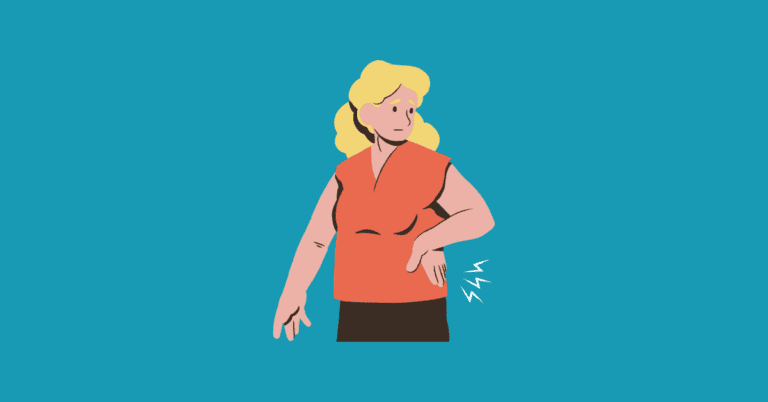TENS vs EMS: Differences Between Both Therapies

If you have worked with a physical therapist or delved into the world of therapeutic technologies, you have likely come across the acronyms TENS and EMS. These two modalities, standing for Transcutaneous Electrical Nerve Stimulation and Electrical Muscle Stimulation, respectively, share a common foundation of electrical pulses, yet their applications and impacts on the body are distinct. So TENS vs EMS?
Electrical stimulation (e-stim or electrotherapy) has various applications, including reducing inflammation, promoting the growth of bone and tendon, facilitating wound healing, aiding in muscle reeducation, and strengthening muscles.
TENS VS EMS – Now, if you just want the quick summary, here it is:
Both TENS & EMS utilize electric stimulation.
The main difference between the two lies in amplitude, which refers to the intensity of the electric stimulation.
In general, EMS = higher intensity of stimulation.
So, EMS primarily targets muscle stimulation, inducing muscle contractions to promote strength gain.
TENS is for pain relief, generally without aiming for muscle contractions.
So by default, any EMS unit automatically encompasses TENS functions as well. All you need to do is reduce the intensity of the stimulation, a feature controlled by the user. However, it’s worth noting that TENS and EMS have different parameters or settings for stimulation, such as frequency, on/off time, and treatment time. Whether these settings can be controlled by the user depends on the specific unit.

Did I blow your mind?
Or should I say shock your mind? → on a more serious note though, this is a joke. Let’s dispel any notions of electrifying shocks. TENS and EMS, while involving electrical stimulation, are far from the dramatic image of “shocking” your body or the jolting experience you might associate with the word. They operate with control and a relatively lower intensity of stimulation.
Continue reading if you want more information about the differences between TENS and EMS, including the different types of TENS and EMS.
EMS (electrical muscle stimulation)
EMS is a broad term.
In fact, amongst exercise professionals, TENS can fall under the category of electrical muscle stimulation…but if this confuses you, forget that I mentioned this.
Outside of clinical settings, the term “EMS” is generally used to encompass a range of therapies that leverage electrical stimulation to induce muscle contraction, thereby facilitating strength gain.
Aside from muscle strengthening, other benefits of ems include stimulating tendon growth, improving local blood circulation, muscle reeducation, stimulating wound healing, and reduction of pain and inflammation.
Electrode pads are placed over two different sections of the target muscle, more specifically positioned at motor points. These motor points serve as the juncture where nerves enter the muscle and branch out into various motor units.
Within certain healthcare disciplines, particularly among professionals like physical therapists, EMS further branches into specific categories. The most common distinctions within the EMS umbrella are NMES (Neuromuscular Electrical Stimulation) and FES (Functional Electrical Stimulation).

NMES
The main purpose of NMES is strength gain; it can be used for muscle recovery or to prevent muscle atrophy. For NMES to be most effective, the person receiving the stimulation is encouraged to take the highest amplitude that is tolerable by the individual. Which makes sense, right? The stronger the muscle contraction, the greater the strength benefits.
During a NMES treatment session, the unit does not provide impulses the whole time, it’s usually 10-15 secs of stimulation followed by 45-50 second rest for a total of 15 minutes.
Also, NMES is done isometrically, which means that movement caused by the muscle contraction is intentionally restricted for safety and effectiveness. For example, when the quadricep is being stimulated, the contraction will naturally cause the knee to straighten; which is why professionals tie the leg in place with a belt to prevent leg movement.
You may ask, why not just exercise the muscle, instead of using nmes?
In cases or conditions where exercise is limited due to pain, NMES can be very helpful. For example many with osteoarthritis in the knee aren’t able to tolerate heavy-loaded resistance training due to pain. In this case, NMES can be employed alongside modified exercise to improve strength and decrease pain overtime.
Drawing from clinical experience, NMES has been beneficial for individuals recovering from surgery, and injuries; specific examples are ACL reconstruction, total knee replacement, rotator cuff injuries, and achilles ruptures.
FES
FES, functional electrical stimulation, is basically NMES but paired with functional movement. FES stimulation is generally applied with a switch/trigger (which can range from a button to a foot plate that senses pressure). It facilitates the desired movement as soon as the simulation is applied.
The broader application of FES can include strengthening muscle in a functional manner, muscle re-education (re-organizing the brain-muscle connections of the nervous system), improving motor control, and more.
FES emerged as an intervention for individuals with nerve injuries, weakened muscles, or conditions that significantly impact motor control. It can play a pivotal role in facilitating the return to controlled, functional muscular activity.
Unlike other electrical stimulation therapies, FES distinguishes itself by being applied over more extended periods.The rationale behind this approach is rooted in the concept that increased repetitions of the movement contribute to enhanced motor learning. As individuals engage in repeated cycles of stimulation, the nervous system undergoes a process of neuroplasticity, fostering changes in the brain-body connection.
This emphasis on prolonged usage is important for optimal improvement, guiding individuals towards sustained improvements in motor function and fostering a more adaptive neural network.
TENS (transcutaneous electrical nerve stimulation)
As one of the most prevalent commercially utilized electro-stim therapies, transcutaneous electrical nerve stimulation stands out for its primary purpose: pain relief. Since pain management is its primary purpose, TENS is often used for longer periods of time.
Within clinical settings, TENS is often used for pain management such as in patients with back pain, especially during therapeutic exercises. Consider a scenario where pain impedes an individual from engaging in therapeutic activities. In such cases, physical therapists may incorporate TENS to alleviate pain, enabling the individual to participate in exercises crucial for long-term pain reduction.
The mechanics behind TENS involve the activation of mechanical receptors (and nerve endings), initiating signals sent to the brain. This process (known as gate control theory of pain) reduces input from pain receptors, resulting in a diminished perception of pain. There are other proposed mechanisms behind TENS too.

Among exercise professionals, such as a physical therapist, TENS is often broken down into 3 categories: sensory level tens, motor level tens, and noxious tens. Outside of clinical settings, the application of motor level and noxious tens is rarely encountered.

Sensory level TENS
Sensory TENS, the most prevalent type, involves stimulation that doesn’t induce muscle contraction but rather produces a gentle tingling or buzzing sensation. This modality can be an effective pain management strategy for individuals dealing with injuries or chronic pain as it can be easily integrated into daily routines (even during activities).
The intensity of TENS varies from person to person, aiming for a moderate tingling or buzzing sensation during use.
It’s noteworthy that within a few minutes, you may observe a decrease in the perceived intensity of both the TENS-related sensation and your pain levels. This adjustment is entirely normal, indicating your body’s adaptation to the stimulation; this doesn’t imply a reduction in effectiveness as pain is still being managed.
In summary, TENS contributes significantly to pain relief, but it’s not the sole solution. Consider it as a facilitator – a TENS machine enables you to manage pain effectively, empowering you to engage in your daily activities and recommended exercises.
It is this consistent participation in recommended exercises that serves as the cornerstone for achieving lasting, long-term pain relief.
Motor level TENS
Motor level TENS, although not widely used, usually serves a specific purpose in treating trigger points. It’s essentially a heightened version of sensory level TENS, where the intensity is increased enough to cause muscle contractions.
This type of TENS targets the smaller areas of muscle where trigger points are located. By employing electrical impulses to induce muscle contractions in these specific spots, motor level TENS aims to address and alleviate discomfort associated with trigger points.
Noxious TENS
Noxious level TENS finds its primary applications in clinical settings, particularly in the treatment of chronic tendinopathies.
This specialized form of TENS involves the use of small electrodes that target specific, localized areas, creating higher current density for precise treatment.
Notably, noxious TENS may be uncomfortable for users, as it aims to induce a prickly or stinging pain sensation during treatment.
Still, this discomfort does serve a therapeutic purpose, as noxious TENS has demonstrated efficacy in prompting pain relief post-treatment.
Are TENS and EMS units safe?
Yes as long as users adhere to the provided instructions for proper usage.
Given their classification as medical devices, manufacturers adhere to specific guidelines for FDA approval, ensuring legal and regulated distribution.
However, it’s important for users to be aware of certain conditions or areas where caution should be exercised. These include avoiding the application of TENS and EMS over the thoracic region, on individuals with pacemakers, on the front of the neck, over skin injuries or frail skin, on the chest wall, or in the presence of sensory impairments.
It’s important to note that this list is not exhaustive, and users are strongly advised to consult the manual accompanying their devices for comprehensive guidelines, ensuring a safe and effective application of electrical stimulation for therapeutic purposes.
Should I get a TENS and EMS unit?
Investing in a TENS or EMS machine can be valuable for effective pain management, enabling you to maintain daily activities and work commitments.
However, it’s not a cure-all or an excuse for a sedentary lifestyle.
If you’ve found TENS effective in the past for pain relief, I would recommend a home unit especially if it allows adherence to therapeutic exercise with good form.
This commitment to structured exercise and movement is crucial for achieving lasting improvement over time.





